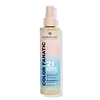What's inside
What's inside
 Key Ingredients
Key Ingredients

No key ingredients
 Benefits
Benefits

 Concerns
Concerns

 Ingredients Side-by-side
Ingredients Side-by-side

Water
Skin ConditioningCocos Nucifera Oil
MaskingAmodimethicone
Polyquaternium-37
PPG-5-Ceteth-10 Phosphate
EmulsifyingPhenoxyethanol
PreservativePropylene Glycol Dicaprylate/Dicaprate
EmollientAcetamide Mea
HumectantSodium Hydroxide
BufferingParfum
MaskingLactamide Mea
HumectantDimethicone
EmollientPPG-1 Trideceth-6
Skin ConditioningButylene Glycol
HumectantTrideceth-6
EmulsifyingBehentrimonium Chloride
PreservativeXylose
HumectantEthylhexylglycerin
Skin ConditioningHelianthus Annuus Seed Extract
Skin ConditioningSorbitan Oleate
EmulsifyingLinalool
PerfumingDimethiconol
EmollientBenzophenone-4
UV AbsorberIsopropyl Alcohol
SolventCetrimonium Chloride
AntimicrobialTocopherol
AntioxidantCamelina Sativa Seed Oil
Skin ConditioningAscorbyl Glucoside
AntioxidantOlea Europaea Fruit Oil
MaskingBenzyl Alcohol
PerfumingGeraniol
PerfumingCitronellol
PerfumingBenzyl Salicylate
PerfumingHydrolyzed Vegetable Protein Pg-Propyl Silanetriol
Skin ConditioningIsoeugenol
PerfumingBHT
AntioxidantMelanin
Skin ProtectingSodium Benzoate
MaskingPentylene Glycol
Skin ConditioningPotassium Sorbate
PreservativeCitric Acid
BufferingWater, Cocos Nucifera Oil, Amodimethicone, Polyquaternium-37, PPG-5-Ceteth-10 Phosphate, Phenoxyethanol, Propylene Glycol Dicaprylate/Dicaprate, Acetamide Mea, Sodium Hydroxide, Parfum, Lactamide Mea, Dimethicone, PPG-1 Trideceth-6, Butylene Glycol, Trideceth-6, Behentrimonium Chloride, Xylose, Ethylhexylglycerin, Helianthus Annuus Seed Extract, Sorbitan Oleate, Linalool, Dimethiconol, Benzophenone-4, Isopropyl Alcohol, Cetrimonium Chloride, Tocopherol, Camelina Sativa Seed Oil, Ascorbyl Glucoside, Olea Europaea Fruit Oil, Benzyl Alcohol, Geraniol, Citronellol, Benzyl Salicylate, Hydrolyzed Vegetable Protein Pg-Propyl Silanetriol, Isoeugenol, BHT, Melanin, Sodium Benzoate, Pentylene Glycol, Potassium Sorbate, Citric Acid
Water
Skin ConditioningPEG-40 Hydrogenated Castor Oil
EmulsifyingButyrospermum Parkii Butter
Skin ConditioningHoney
HumectantYogurt Extract
Skin ConditioningAdansonia Digitata Seed Oil
EmollientTrichilia Emetica Seed Butter
EmollientGlycerin
HumectantPolyquaternium-11
Vp/Va Copolymer
Guar Hydroxypropyltrimonium Chloride
Skin ConditioningCocamidopropyl Betaine
CleansingCitric Acid
BufferingPotassium Sorbate
PreservativePhenoxyethanol
PreservativeParfum
MaskingWater, PEG-40 Hydrogenated Castor Oil, Butyrospermum Parkii Butter, Honey, Yogurt Extract, Adansonia Digitata Seed Oil, Trichilia Emetica Seed Butter, Glycerin, Polyquaternium-11, Vp/Va Copolymer, Guar Hydroxypropyltrimonium Chloride, Cocamidopropyl Betaine, Citric Acid, Potassium Sorbate, Phenoxyethanol, Parfum
 Reviews
Reviews

Ingredients Explained
These ingredients are found in both products.
Ingredients higher up in an ingredient list are typically present in a larger amount.
Citric Acid is an alpha hydroxy acid (AHA) naturally found in citrus fruits like oranges, lemons, and limes.
Like other AHAs, citric acid can exfoliate skin by breaking down the bonds that hold dead skin cells together. This helps reveal smoother and brighter skin underneath.
However, this exfoliating effect only happens at high concentrations (20%) which can be hard to find in cosmetic products.
Due to this, citric acid is usually included in small amounts as a pH adjuster. This helps keep products slightly more acidic and compatible with skin's natural pH.
In skincare formulas, citric acid can:
While it can provide some skin benefits, research shows lactic acid and glycolic acid are generally more effective and less irritating exfoliants.
Most citric acid used in skincare today is made by fermenting sugars (usually from molasses). This synthetic version is identical to the natural citrus form but easier to stabilize and use in formulations.
Read more about some other popular AHA's here:
Learn more about Citric AcidParfum is a catch-all term for an ingredient or more that is used to give a scent to products.
Also called "fragrance", this ingredient can be a blend of hundreds of chemicals or plant oils. This means every product with "fragrance" or "parfum" in the ingredients list is a different mixture.
For instance, Habanolide is a proprietary trade name for a specific aroma chemical. When used as a fragrance ingredient in cosmetics, most aroma chemicals fall under the broad labeling category of “FRAGRANCE” or “PARFUM” according to EU and US regulations.
The term 'parfum' or 'fragrance' is not regulated in many countries. In many cases, it is up to the brand to define this term.
For instance, many brands choose to label themselves as "fragrance-free" because they are not using synthetic fragrances. However, their products may still contain ingredients such as essential oils that are considered a fragrance by INCI standards.
One example is Calendula flower extract. Calendula is an essential oil that still imparts a scent or 'fragrance'.
Depending on the blend, the ingredients in the mixture can cause allergies and sensitivities on the skin. Some ingredients that are known EU allergens include linalool and citronellol.
Parfum can also be used to mask or cover an unpleasant scent.
The bottom line is: not all fragrances/parfum/ingredients are created equally. If you are worried about fragrances, we recommend taking a closer look at an ingredient. And of course, we always recommend speaking with a professional.
Learn more about ParfumPhenoxyethanol is a preservative that has germicide, antimicrobial, and aromatic properties. Studies show that phenoxyethanol can prevent microbial growth. By itself, it has a scent that is similar to that of a rose.
It's often used in formulations along with Caprylyl Glycol to preserve the shelf life of products.
Potassium Sorbate is a preservative used to prevent yeast and mold in products. It is commonly found in both cosmetic and food products.
This ingredient comes from potassium salt derived from sorbic acid. Sorbic acid is a natural antibiotic and effective against fungus.
Both potassium sorbate and sorbic acid can be found in baked goods, cheeses, dried meats, dried fruit, ice cream, pickles, wine, yogurt, and more.
You'll often find this ingredient used with other preservatives.
Learn more about Potassium SorbateWater. It's the most common cosmetic ingredient of all. You'll usually see it at the top of ingredient lists, meaning that it makes up the largest part of the product.
So why is it so popular? Water most often acts as a solvent - this means that it helps dissolve other ingredients into the formulation.
You'll also recognize water as that liquid we all need to stay alive. If you see this, drink a glass of water. Stay hydrated!
Learn more about Water